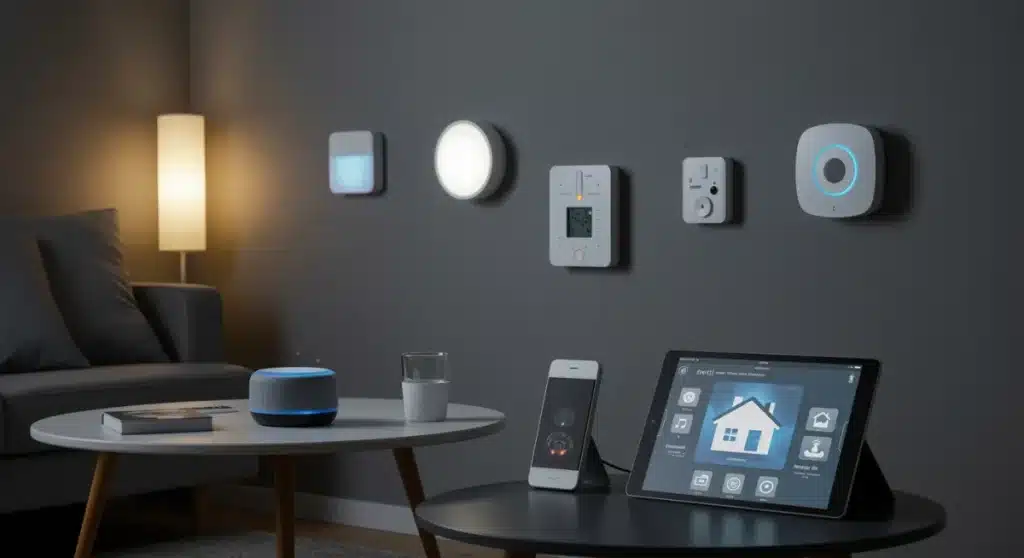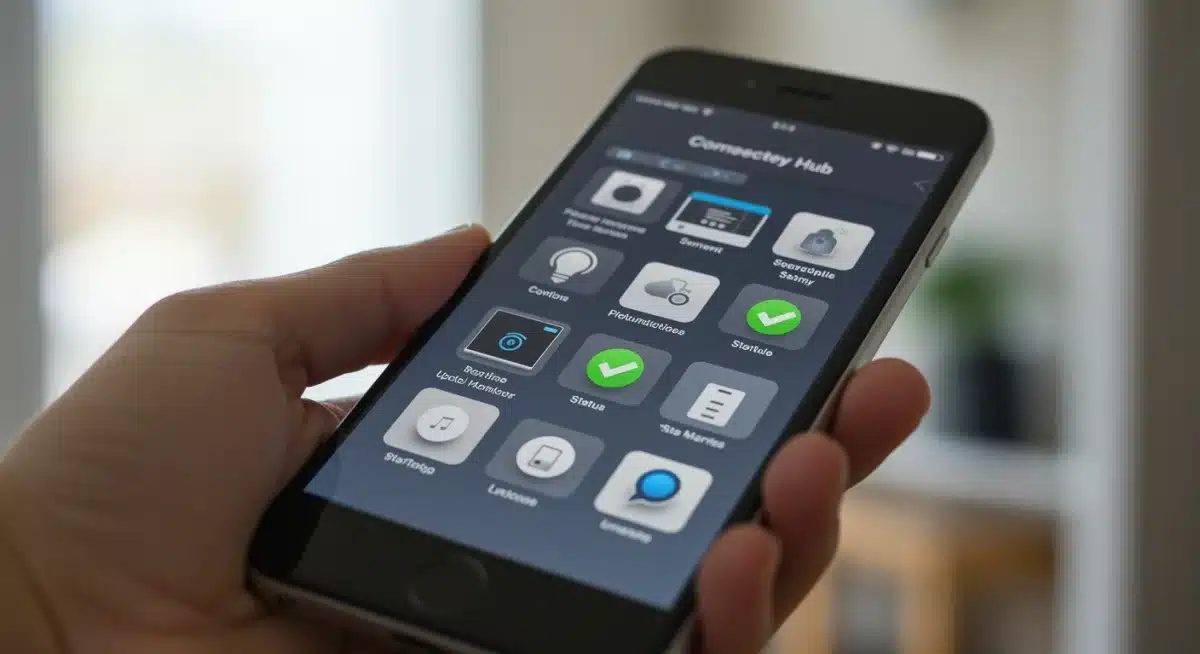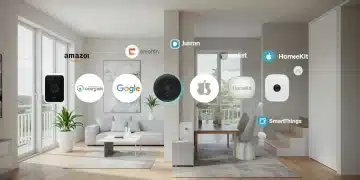Integrating Smart Home Devices: Avoiding Compatibility Issues in 2025

Integrating smart home devices in 2025 requires navigating evolving compatibility standards and manufacturer ecosystems to ensure seamless operation and avoid frustrating interoperability issues.
Integrating Smart Home Devices: Avoiding Compatibility Issues in 2025 remains a critical concern for consumers and developers alike, as the promise of a fully connected home often clashes with the reality of fragmented ecosystems. This report details the current landscape and offers practical solutions to ensure your smart home operates smoothly.
Understanding the Current Smart Home Landscape in 2025
As of early 2025, the smart home market continues its rapid expansion, introducing an array of innovative devices designed to enhance convenience, security, and energy efficiency. However, this proliferation also brings increased complexity, particularly concerning device interoperability and compatibility. Consumers are often faced with a bewildering choice of products, each promising seamless integration, but frequently failing to deliver when combined with devices from different manufacturers.
This evolving landscape is heavily influenced by competing communication protocols and proprietary platforms. While efforts like Matter aim to standardize connectivity, their full impact is still unfolding. Understanding these foundational elements is crucial for anyone looking to build or expand a truly integrated smart home system without encountering significant hurdles.
The Rise of Universal Standards and Their Impact
The push for universal standards, most notably Matter, has gained considerable momentum heading into 2025. This initiative aims to simplify connectivity across various brands and ecosystems, promising a future where devices ‘just work’ together, regardless of their manufacturer. Matter, backed by major industry players, leverages existing technologies like Wi-Fi, Thread, and Bluetooth Low Energy to create a unified application layer for smart home devices.
- Unified Connectivity: Matter allows devices from different brands to communicate directly, reducing reliance on multiple apps and hubs.
- Enhanced Security: Standardized security protocols embedded within Matter aim to improve data protection and privacy for smart home users.
- Simplified Setup: The goal is to streamline the pairing process, making it easier for consumers to add new devices to their existing smart home setups.
Navigating Proprietary Ecosystems
Despite the emergence of universal standards, proprietary ecosystems remain a dominant force in the smart home market. Companies like Apple (HomeKit), Google (Google Home), and Amazon (Alexa) continue to develop and promote their own platforms, often offering exclusive features and deeper integration with their respective services. While these ecosystems can provide a highly curated and reliable experience within their boundaries, they can also create silos, making it challenging to integrate devices that fall outside their native support.
Consumers frequently find themselves choosing between the convenience of a single-brand ecosystem and the desire for diverse device functionalities. This dynamic requires careful consideration when purchasing new smart home products, as compatibility with a chosen ecosystem often dictates the overall user experience and the level of functionality achievable.
Pre-Purchase Planning: Essential Steps for Seamless Integration
Effective integration of smart home devices begins long before any purchase is made. A strategic pre-purchase planning phase is paramount to avoiding compatibility pitfalls and ensuring a cohesive smart home ecosystem. This involves thorough research, understanding your specific needs, and verifying device interoperability with your existing setup or chosen platform. Haphazard buying can lead to frustrating incompatibilities, redundancy, and ultimately, a less intelligent home.
By taking the time to plan meticulously, you can save both time and money, and create a smart home that truly enhances your daily life rather than complicates it. Focusing on foundational elements and future-proofing your choices are key components of this initial stage.
Researching Compatibility Standards and Protocols
Before investing in any smart home device, it is crucial to research the compatibility standards and communication protocols it supports. This means looking beyond marketing claims and delving into the technical specifications. Does the device support Matter, Zigbee, Z-Wave, Wi-Fi, or Bluetooth? More importantly, does it support the protocols used by your existing smart home hub or other devices you plan to integrate?
- Check for Matter Certification: Prioritize devices with Matter certification for the broadest compatibility and future-proofing.
- Verify Ecosystem Support: Ensure new devices are explicitly listed as compatible with your primary smart home ecosystem (e.g., HomeKit, Alexa, Google Home).
- Understand Network Requirements: Some devices require specific Wi-Fi bands (2.4GHz vs. 5GHz) or a dedicated hub for optimal performance.
Choosing a Central Smart Home Hub or Platform
The selection of a central smart home hub or platform is perhaps the most critical decision in your pre-purchase planning. This hub acts as the brain of your smart home, facilitating communication between various devices and enabling automation routines. Popular choices include Amazon Echo devices, Google Nest Hubs, Apple HomePods, and dedicated smart home controllers like Hubitat or SmartThings.
Your chosen hub will largely dictate the range of compatible devices and the ease of integration. It’s essential to select a platform that aligns with your preferred user interface, voice assistant preferences, and the types of devices you intend to use. A robust hub can bridge compatibility gaps and provide a unified control experience.
Leveraging Universal Standards and Open Platforms
The drive towards universal standards and open platforms is a significant development in the smart home industry, offering a pathway to overcome the long-standing challenges of device compatibility. These initiatives aim to create a more interconnected and user-friendly experience, moving away from proprietary lock-ins and towards true interoperability. Embracing these standards is a proactive step for anyone looking to build a flexible and future-proof smart home system.
Understanding how to leverage these emerging technologies can dramatically simplify the integration process and expand the possibilities for home automation, allowing for a mix-and-match approach to device selection without sacrificing functionality.
Embracing Matter for Device Interoperability
Matter, as a unified, IP-based connectivity standard, is positioned to revolutionize smart home device integration in 2025. By providing a common language for devices, it eliminates the need for complex workarounds and multiple apps to control different brands of smart products. When selecting new devices, prioritizing those with Matter certification is a sound strategy to ensure broad compatibility and ease of setup.
The standard supports a wide range of device types, from lighting and thermostats to locks and sensors, and is designed to work over existing network technologies. This means that devices from different manufacturers, all supporting Matter, can seamlessly communicate and be controlled through a single interface, regardless of the underlying ecosystem (e.g., Apple Home, Google Home, Alexa).
Exploring Open-Source Smart Home Platforms
For users seeking ultimate control and customization, open-source smart home platforms offer a powerful alternative to commercial ecosystems. Platforms like Home Assistant provide a highly flexible environment where users can integrate virtually any smart device, regardless of its original manufacturer or protocol. These platforms typically require a higher level of technical expertise but offer unparalleled freedom and the ability to create highly sophisticated automation routines.
Open-source solutions often have vibrant communities that contribute drivers and integrations for new devices, ensuring a broader range of compatibility than many proprietary systems. They also offer greater privacy control, as data typically remains within your local network rather than being sent to cloud servers.
Advanced Strategies for Bridging Compatibility Gaps
Even with careful planning and the adoption of universal standards, situations may arise where desired devices do not natively communicate with your chosen ecosystem. In such scenarios, advanced strategies are required to bridge these compatibility gaps, allowing you to incorporate a wider range of smart home products without compromising functionality. These methods often involve intermediary software or hardware solutions that translate between different communication protocols or platforms.
Implementing these solutions can extend the capabilities of your smart home, enabling a truly personalized and comprehensive automation experience, even with disparate devices. It requires a bit more technical savvy but yields significant rewards in flexibility.
Utilizing Third-Party Integration Services
Third-party integration services, such as IFTTT (If This Then That) or Zapier, act as powerful connectors between various smart home devices and web services that might not otherwise communicate. These platforms allow users to create custom automation rules (applets or zaps) that trigger actions across different brands and ecosystems. For example, you could set up a rule where a motion sensor from one brand triggers a light from another, even if they don’t natively support each other.
These services are particularly useful for creating complex, multi-device automations and for integrating smart home devices with other aspects of your digital life, such as calendars, weather apps, or social media. They provide a flexible layer of control, extending the reach of your smart home beyond its immediate hardware.
Implementing Local Control and Hub-to-Hub Communication
For enhanced reliability and privacy, focusing on local control and enabling hub-to-hub communication can significantly improve smart home integration. Local control means devices operate without constant reliance on the internet or cloud services, making them faster and more resilient to outages. Many modern hubs and devices now offer local control options.

Hub-to-hub communication, often facilitated by open platforms or specific integrations, allows different smart home hubs to share device information and trigger actions. For instance, a Zigbee hub could expose its connected devices to a HomeKit hub, allowing them to be controlled via Apple’s ecosystem. This approach creates a more robust and interconnected smart home, reducing single points of failure and maximizing device utility.
Maintaining and Troubleshooting Your Integrated Smart Home
Even after successfully integrating your smart home devices, ongoing maintenance and effective troubleshooting are essential to ensure long-term stability and performance. The dynamic nature of smart home technology means that firmware updates, network changes, and new device introductions can sometimes disrupt previously stable setups. Proactive management can prevent minor glitches from escalating into significant system failures, ensuring your smart home remains truly smart.
Regular checks and a systematic approach to problem-solving will help you keep your integrated system running smoothly and efficiently, adapting to new challenges as they arise in the ever-evolving smart home ecosystem.
Regular Firmware and Software Updates
One of the most critical aspects of maintaining an integrated smart home is consistently applying firmware and software updates to all your devices and hubs. Manufacturers frequently release updates to improve performance, patch security vulnerabilities, and enhance compatibility with new standards or devices. Neglecting these updates can lead to security risks, performance degradation, and, crucially, compatibility issues with other devices.
- Enable Automatic Updates: Where possible, enable automatic updates for your smart home hubs and critical devices.
- Manual Checks: Regularly check manufacturer websites or device apps for manual updates, especially for less frequently updated devices.
- Review Changelogs: Before updating, quickly review changelogs to understand what changes are being made and if there are any known issues.
Network Optimization and Diagnostics
A stable and robust home network is the backbone of any integrated smart home. Many compatibility issues can be traced back to an overloaded, poorly configured, or unreliable Wi-Fi network. Regular network optimization and diagnostic checks are therefore essential. This includes ensuring adequate Wi-Fi coverage, managing channel interference, and understanding network traffic.
Consider upgrading your router if it’s outdated or struggling to handle the number of connected devices. Utilizing network analysis tools can help identify bottlenecks or areas of poor signal strength. Segmenting your smart devices onto a separate network (VLAN) can also improve security and performance. A healthy network ensures that all your smart devices can communicate efficiently and reliably, minimizing dropped connections and responsiveness issues.
Future-Proofing Your Smart Home Investments
In a rapidly evolving technological landscape, future-proofing your smart home investments is paramount to ensure longevity and avoid premature obsolescence. This involves making informed decisions today that will stand the test of time, adapting to new standards and innovations without requiring a complete overhaul of your system. A forward-thinking approach can save significant costs and frustration in the long run, guaranteeing that your smart home remains relevant and functional for years to come.
Focusing on open standards, reputable brands, and modularity are key components of building a resilient and adaptable smart home infrastructure that can evolve alongside technology.
Prioritizing Open Standards and Established Brands
When making new smart home purchases, prioritize devices that adhere to open industry standards, such as Matter, Zigbee, or Z-Wave, rather than proprietary protocols. Open standards foster greater interoperability and are more likely to receive ongoing support and updates from a wider community of developers and manufacturers. This reduces the risk of devices becoming obsolete if a single company changes its strategy or exits the market.
Furthermore, investing in products from established and reputable brands generally offers a higher degree of reliability, better customer support, and a greater likelihood of long-term software and firmware updates. These brands often have a vested interest in maintaining compatibility and supporting their product lines for extended periods, providing a safer bet for future-proofing your home.
Modular Design and Scalability Considerations
Designing your smart home with modularity and scalability in mind is a critical strategy for future-proofing. Instead of committing to a single, monolithic system, consider building your smart home with components that can be easily added, removed, or upgraded as your needs change or new technologies emerge. This approach allows for flexibility and prevents the entire system from becoming outdated due to a single component.
For instance, opting for a hub that supports multiple protocols allows you to integrate diverse devices without being locked into one brand. Choosing devices that can function independently or be easily reconfigured for different purposes also adds to the system’s adaptability. A modular smart home can grow and evolve with technology, ensuring your initial investments continue to provide value over time.
Emerging Trends and Their Impact on Compatibility
The smart home industry is constantly innovating, with new technologies and trends emerging that will undoubtedly shape the future of device compatibility. Staying informed about these developments is crucial for anyone looking to maintain a cutting-edge and seamlessly integrated smart home. These trends often bring both new opportunities for enhanced functionality and potential challenges for ensuring interoperability with existing systems.
Understanding these shifts allows for proactive planning and strategic investment, ensuring your smart home remains at the forefront of technological advancement and avoids future compatibility headaches.
AI and Machine Learning Integration
The increasing integration of artificial intelligence (AI) and machine learning (ML) into smart home devices is a significant trend that will profoundly impact compatibility. AI-powered devices are becoming more capable of learning user habits, optimizing energy consumption, and providing more personalized automation. This often requires robust communication between devices to share data and insights, making standardized data exchange protocols even more vital.
While AI can enhance device intelligence, it also introduces complexities related to data privacy and the need for devices to understand and process information from various sources. Compatibility will extend beyond simple connectivity to include the ability to share and interpret AI-generated insights across different platforms seamlessly.
Enhanced Privacy and Security Protocols
With the growing number of connected devices in homes, concerns around privacy and security are escalating. Future smart home compatibility will increasingly hinge on devices adhering to stringent privacy standards and robust security protocols. Consumers are demanding greater transparency about how their data is collected, stored, and used, and regulators are responding with stricter guidelines.
Devices that prioritize end-to-end encryption, local processing of sensitive data, and clear privacy policies will likely gain favor. Compatibility will not just be about devices talking to each other, but also about them doing so securely and respecting user privacy preferences. This focus will drive the adoption of new security standards and potentially influence which brands and products gain widespread acceptance in the integrated smart home ecosystem.
| Key Point | Brief Description |
|---|---|
| Embrace Matter Standard | Prioritize devices certified with Matter for broad interoperability across various smart home ecosystems, simplifying setup and control. |
| Pre-Purchase Planning | Thoroughly research device compatibility and choose a central hub before buying to avoid integration issues and ensure a cohesive system. |
| Leverage Third-Party Integrations | Utilize services like IFTTT or Zapier to connect devices and platforms that lack native compatibility, expanding automation possibilities. |
| Regular Updates & Network Health | Keep all device firmware and software updated, and ensure a robust, optimized home network for stable and reliable smart home operation. |
Frequently Asked Questions About Smart Home Compatibility
Matter is a new universal, open-source connectivity standard for smart home devices. It allows products from different brands to communicate seamlessly, reducing the need for multiple apps and hubs. By providing a common language, Matter simplifies device setup and integration, aiming to eliminate compatibility headaches for consumers in 2025 and beyond.
While sticking to one ecosystem (e.g., Apple Home, Alexa, Google Home) can offer deep integration and simplicity, it limits device choice. Mixing and matching is becoming more viable with standards like Matter. For optimal results, choose a primary hub that supports open standards and then selectively add devices that specifically state compatibility with your chosen hub or Matter.
Smart home hubs act as central controllers, translating communication between devices that use different protocols (like Zigbee, Z-Wave, Wi-Fi). A well-chosen hub can bridge compatibility gaps, allowing diverse devices to work together within a single interface. They are crucial for creating complex automation routines and enhancing overall system stability.
Firmware updates are extremely important. They often include critical security patches, performance improvements, and enhanced compatibility with new standards or devices. Neglecting updates can lead to vulnerabilities, reduced functionality, and potential compatibility issues. Always keep your devices and hubs updated to ensure optimal and secure operation.
Integrating older devices with newer ones can be challenging but is often possible. Using a robust smart home hub that supports multiple protocols (e.g., Zigbee, Z-Wave) can help. Third-party integration services like IFTTT can also create bridges between incompatible generations or brands. Prioritize devices supporting open standards for better long-term interoperability.
What Happens Next
The landscape for Integrating Smart Home Devices: Avoiding Compatibility Issues in 2025 is set to evolve further, with the full impact of Matter certification still unfolding across product lines. Consumers should anticipate a clearer, albeit not entirely seamless, path to device integration. Watch for increased adoption of AI-driven automation, which will demand even more robust and standardized communication protocols. The industry is moving towards a more unified experience, but vigilance in pre-purchase planning and ongoing system maintenance will remain critical for a truly smart and functional home. Expect continuous updates to existing standards and the emergence of new solutions to address the ever-growing complexity of connected living.





